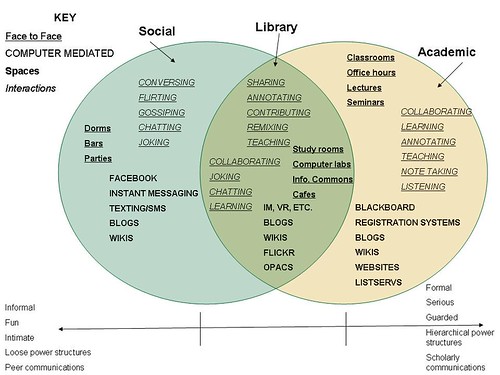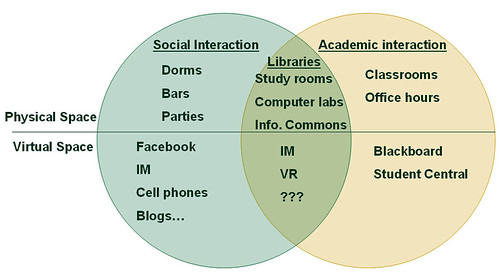-
We’re Not Dead Yet! – 11/15/2004 – Library Journal
“University presses can survive and thrive if university libraries work with them to create a sustainable future for scholarly communication” by Barbara Fister and Niko Pfund — Library Journal, 11/15/2004
-
AAUP & ARL: 2004 The Year of the University Press
“The Development of an Open Source Publishing System by Terry Ehling, Director of Electronic Publishing at Cornell University Library. Prior to her Cornell appointment, she was Manager of the Digital Projects Lab at the MIT Press. “
-
“The adoption of open-source publishing systems like DPubS can correct the imbalance in the scholarly communication environment by providing a venue for nontraditional publishing initiatives.”
-
“University presses are at the cutting edge of electronic publishing, often working in collaboration with each other, with their university libraries, and with scholarly societies. Below are links to some of the e-Publishing initiatives currently under wa
Category: academic libraries
Toward Academic Library 2.0: Development and Application of a Library 2.0 Methodology (My Master’s Paper)
Title: Toward Academic Library 2.0: Development and Application of a Library 2.0 Methodology
Authors: Michael C. Habib
Issue Date: 17-Nov-2006
Publisher: School of Information and Library Science
Abstract: Recently, librarians have struggled to understand their relationship to a new breed of Web services that, like libraries, connect users with the information they need. These services, known as Web 2.0, offer new service models, methods, and technologies that can be adapted to improve library services. Additionally, these services affect library user’s information seeking behaviors, communication styles, and expectations. The term Library 2.0 has been introduced into the professional language of librarianship as a way to discuss these changes. This paper works to establish a theoretical foundation of Library 2.0 in academic libraries, or Academic Library 2.0.
URI: http://hdl.handle.net/1901/356
Repository record: http://dc.lib.unc.edu/cdm/ref/collection/s_papers/id/905
Local copy: http://mchabib.com/masterspaper.pdf
__
I look forward to hearing your thoughts on the paper. Please leave feedback in the comments. Thanks.
Academic Library 2.0 Concept Models (Basic v2 and Detailed)
I have updated the original Academic Library 2.0 Concept Model. The new version aims to maintain the simplicity of the original, while adding a few examples and using more precise language. Also worth noting is that the line separating the physical and virtual environments is now dotted to signify the artificial nature of this boundary.
This model presents a view of how students might view the library as place in relation to their academic and social lives. It is at this intersection that I propose Library 2.0 has begun to materialize. The primary goal of the model is to encourage brainstorming over how we can develop virtual environments that will fit into students’ lives. However, I would argue that new collaborative spaces in the physical environment could also be viewed as part of L2 in so much as they are responses to changing learning styles that are partially brought on by the social nature of Web 2.0 tools. In this way, a definition of L2 that focuses on Web 2.0 might include some innovative services in the physical environment. This said, it is my belief that L2 is primarily useful as a concept for developing new online tools. To learn more about this model, you can check out the post accompanying the first model here. The comments and links at the bottom of that page will help guide one through the discussions of the original model.
I have also created a more detailed version of the model. In this version the boundary between physical and virtual has vanished. Furthermore, this model includes interaction types as well as places. Instead of focusing on exact tasks such as shaking hands (physical) or commenting (virtual), I have looked at interactions in a broader way. At this point, the key is a little confusing on the model, so please use the revised key posted below the model. However, the basic goal is to get people thinking about designing virtual and physical places according to the types of social interactions our patrons will be having in those environments. You will also notice that ALL of the interactions mentioned occur in both the physical and virtual places. Of course we will be seeing more places inhabiting both physical and virtual as well. For example, virtual group study rooms might supplement our physical study rooms.
The scale at the bottom of the model highlights some of the key spectra that lie between a student’s social and academic lives. Again, it is my argument that the library inhabits a space somewhere in the middle ground between these extremes.
underlined = physical
uppercase = virtual
interactions or spaces can be both
———————————-
non-italics = spaces
italics = interactions)
I am still working on these models and final drafts will be included in the second part of my Master’s Paper. I am also developing a model to describe Library 2.0 in general. I should have the paper done relatively soon and will post a link to it. Furthermore, the structure of the paper should work well for filling in the wiki that I proposed here.
As always, I encourage feedback. You are welcome to leave comments here or on your own blog. If you are linking to the image on Flickr, please link to this post as well, so that your contribution to the discussion will be included on this page. Thanks.
Technorati tags: library 2.0 library-20 library2.0 L2 web 2.0 web2.0 academic libraries academiclibrary20
Responses to Academic L2 Concept Model
Again, thanks to Michael Stephens for pointing my model out to the readers of Tame The Web. Since his post, my model has been viewed over 300 times. Over 100 readers continued on to my blog to view the post. So far I have found three other blog entries about it. I would like to share my responses to each of these four posts. I will address them in the order the were discovered.
1. Tame the Web: Michael liked “the blend of technology, space and people!” I wish I could have stated it so succinctly. It is about where people live and work and how they interact in those spaces.
2. Rick L. Fought at The Bailey Blog posted about the model asking his readers, “What do you think of his blending of the library and technology?” What I like best is that this appears to be the blog for librarians at the Bailey Library, Hendrix College. This demonstrates that they are atarting to build these spaces for their librarians. I notice they have a wiki as well.
3. Peta at Innovate noticed the ??? and posed the central question the model was meant to get people thinking about: “Ok, what else goes below the line in the green Libraries area?” This is exactly the kind of brainstorming I hoped to facilitate. How can this model get us thinking about what new services we should provide? To see some of her answers, you can view her post here.
4. Jennifer of Life as I Know It argues that many Academic libraries identify solely with the academic side of the spectrum. When I made the model, I was trying to explore the virtual side of things. I am now thinking it might also be a helpful tool for explaining new services in the physical library. She states:
I think many academic libraries identify solely with the academic part of the college experience – and this might account for some of the hesitation in adopting social software. Often if something doesn’t support the academic mission of the college, it gets vetoed. However, it would be difficult to argue that libraries are not social spaces – just social spaces in which academic endeavors take place.
Technorati tags: library 2.0 academiclibrary20
Conceptual model for Academic Library 2.0
I developed the above model for a paper I wrote for INLS 342: Academic Libraries Seminar. This is very much a work in progress. I hope to explore this area further for my Master’s Paper.
The paper was titled Defining Academic Library 2.0. However, in it I argue for a narrower definition of Library 2.0 than the broader definitions proposed by Michael Casey and Michael Stephens. My narrower definition is as follows:
The application and adaptation of the Web 2.0 model to the library environment (both virtual and physical).
Consequently, the above model proposes a way to look at the libraries role in students lives in a Web 2.0 world.
Below is a slightly edited excerpt from my paper:
One approach to adapting Web 2.0 technologies to academic library services is to examine how these technologies already fit into student life and then determine the library’s role in this picture. Figure 2 introduces one conceptual framework that applies this method. This model analyzes the libraries’ position as a physical place in student life and then draws parallels with libraries’ possible position as a virtual place. The model is based on the concept that most of student life is divided between the social and the academic and that physical libraries have traditionally provided a unique location that mixes the two. A more precise model would show a spectrum between social and academic places with libraries falling near the middle. At one end is the strictly academic formal classroom. Here the professor is an authority to the student. At the opposite end is a party, a purely social occasion. Libraries have traditionally provided a place where students could collaborate on school work without the pressure of being watched by an authority figure, thus allowing them to socialize while they work. Of course, this space also provided students with whatever research materials and reference assistance they might need. Towards this end, librarians have traditionally tried to maintain strict patron confidentiality so as to keep the library a safe haven from authority. Furthermore, many academic libraries now provide popular materials collections to provide residential students with materials for pleasure reading, thus further blending the line between social and academic space. Recent trends in academic libraries have moved closer to blending this line by adding coffee shops, WiFi access and Information Commons. If one accepts that the physical library provides students with this blended environment, then one might ask, “How might the library provide a similar virtual space?†To find an answer to this question, this conceptual model creates a parallel spectrum describing a student’s virtual life. At the academic end of the spectrum, lies course management software such as Blackboard. Similar to the classroom, this space is controlled by the professor and has the same authority structure. On the social end of the spectrum, is Facebook. Students traditionally think of this as a safe social place devoid of authority figures. This is demonstrated by the fact that students have recently been punished for information they post to Facebook. To examine this phenomenon, one need only Google “facebook†and “disciplineâ€. Stutzman’s research demonstrates this feeling of safety (2005; 2006). Given this spectrum, what virtual place might the library provide for students? One possibility would be virtual group study rooms. Such a place might provide the tools to enable students to collaborate remotely and asynchronously on course projects. This space might also provide resources and links to live reference help to assist students in their work. This place would be different from Blackboard because professors would not be able to review students’ discussions. This proposal is just one possibility; hopefully this conceptual framework suggests others. This conceptual framework only suggests one way to examine how academic libraries might apply Web 2.0 concepts to their mission. Another way is to examine what data academic libraries have available.
To learn more about my vision for Academic Library 2.0, you can view a copy of the accompanying presentation here (.pdf)
library 2.0web 2.0 academiclibrary20


